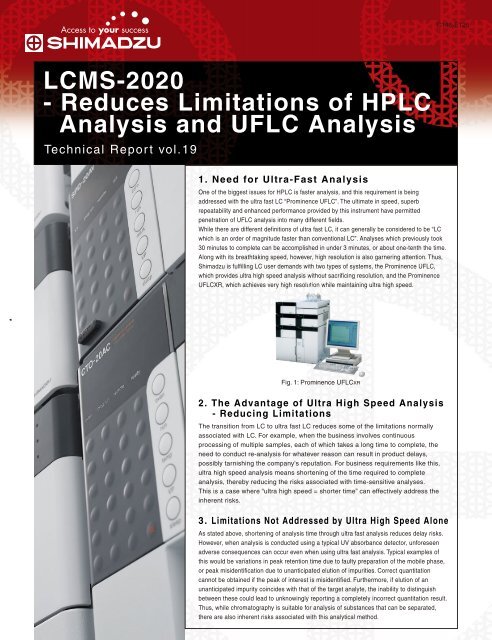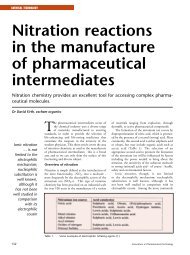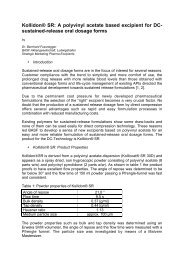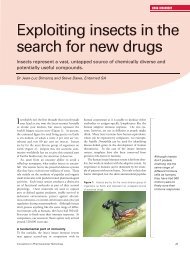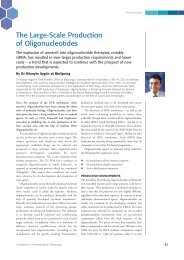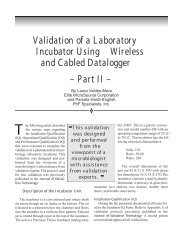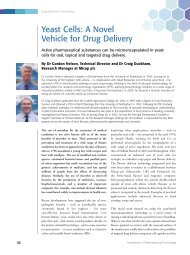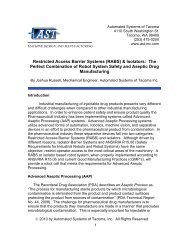LCMS-2020 - Reduces Limitations of HPLC Analysis ... - Shimadzu
LCMS-2020 - Reduces Limitations of HPLC Analysis ... - Shimadzu
LCMS-2020 - Reduces Limitations of HPLC Analysis ... - Shimadzu
Create successful ePaper yourself
Turn your PDF publications into a flip-book with our unique Google optimized e-Paper software.
C146-E125<br />
<strong>LCMS</strong>-<strong>2020</strong><br />
- <strong>Reduces</strong> <strong>Limitations</strong> <strong>of</strong> <strong>HPLC</strong><br />
<strong>Analysis</strong> and UFLC <strong>Analysis</strong><br />
Technical Report vol.19<br />
1. Need for Ultra-Fast <strong>Analysis</strong><br />
One <strong>of</strong> the biggest issues for <strong>HPLC</strong> is faster analysis, and this requirement is being<br />
addressed with the ultra fast LC “Prominence UFLC”. The ultimate in speed, superb<br />
repeatability and enhanced performance provided by this instrument have permitted<br />
penetration <strong>of</strong> UFLC analysis into many different fields.<br />
While there are different definitions <strong>of</strong> ultra fast LC, it can generally be considered to be “LC<br />
which is an order <strong>of</strong> magnitude faster than conventional LC”. Analyses which previously took<br />
30 minutes to complete can be accomplished in under 3 minutes, or about one-tenth the time.<br />
Along with its breathtaking speed, however, high resolution is also garnering attention. Thus,<br />
<strong>Shimadzu</strong> is fulfilling LC user demands with two types <strong>of</strong> systems, the Prominence UFLC,<br />
which provides ultra high speed analysis without sacrificing resolution, and the Prominence<br />
UFLCXR, which achieves very high resolution while maintaining ultra high speed.<br />
Fig. 1: Prominence UFLCXR<br />
2. The Advantage <strong>of</strong> Ultra High Speed <strong>Analysis</strong><br />
- Reducing <strong>Limitations</strong><br />
The transition from LC to ultra fast LC reduces some <strong>of</strong> the limitations normally<br />
associated with LC. For example, when the business involves continuous<br />
processing <strong>of</strong> multiple samples, each <strong>of</strong> which takes a long time to complete, the<br />
need to conduct re-analysis for whatever reason can result in product delays,<br />
possibly tarnishing the company's reputation. For business requirements like this,<br />
ultra high speed analysis means shortening <strong>of</strong> the time required to complete<br />
analysis, thereby reducing the risks associated with time-sensitive analyses.<br />
This is a case where “ultra high speed = shorter time” can effectively address the<br />
inherent risks.<br />
3. <strong>Limitations</strong> Not Addressed by Ultra High Speed Alone<br />
As stated above, shortening <strong>of</strong> analysis time through ultra fast analysis reduces delay risks.<br />
However, when analysis is conducted using a typical UV absorbance detector, unforeseen<br />
adverse consequences can occur even when using ultra fast analysis. Typical examples <strong>of</strong><br />
this would be variations in peak retention time due to faulty preparation <strong>of</strong> the mobile phase,<br />
or peak misidentification due to unanticipated elution <strong>of</strong> impurities. Correct quantitation<br />
cannot be obtained if the peak <strong>of</strong> interest is misidentified. Furthermore, if elution <strong>of</strong> an<br />
unanticipated impurity coincides with that <strong>of</strong> the target analyte, the inability to distinguish<br />
between these could lead to unknowingly reporting a completely incorrect quantitation result.<br />
Thus, while chromatography is suitable for analysis <strong>of</strong> substances that can be separated,<br />
there are also inherent risks associated with this analytical method.
4. Reducing <strong>Limitations</strong> <strong>of</strong> LC <strong>Analysis</strong><br />
Are there any remedies available for reducing the inherent limitations <strong>of</strong><br />
LC analysis? One approach would be to conduct a thorough<br />
investigation when developing the analytical method. In addition to this,<br />
it is necessary to ascertain that such limitations are reduced during<br />
actual routine analysis.<br />
When LC analysis is conducted using an ordinary detector like an<br />
absorbance detector, only retention time information can be considered<br />
reliable, and this single-criterion evaluation can lead to greater risk<br />
exposure. If useful information other than retention time could be<br />
obtained, the inherent limitations <strong>of</strong> LC analysis would be reduced.<br />
Positive ion<br />
measurement<br />
SIM 2CH<br />
15 milliseconds<br />
polarity switching<br />
Negative ion<br />
measurement<br />
SIM 2CH<br />
15 milliseconds<br />
polarity switching<br />
Positive ion<br />
measurement<br />
SIM 2CH<br />
5. Use <strong>of</strong> MS as an LC Detector<br />
One method <strong>of</strong> obtaining new and more useful information is to use a<br />
mass spectrometer (MS) as an LC detector. The greatest advantage <strong>of</strong><br />
using an MS as an LC detector is that mass information for each peak<br />
can easily be obtained at the same time as the respective retention<br />
times. The availability <strong>of</strong> such mass information provides a powerful<br />
means <strong>of</strong> reducing the possibility <strong>of</strong> peak misidentification and elution <strong>of</strong><br />
unanticipated impurities inherent in LC analysis. It also allows for better<br />
quantitation in the case <strong>of</strong> overlapping peaks.<br />
However, setting up an MS as an LC detector normally requires<br />
transformation <strong>of</strong> a typical LC into an ultra high speed LC to enable ultra<br />
fast analysis. This is because, in the case <strong>of</strong> “ultra fast LC + MS”, ultra<br />
high speed MS measurement performance is required to detect and<br />
quantitate the peaks generated at ultra high speed.<br />
6. Birth <strong>of</strong> the Single Quadrupole<br />
Ultra-Fast LC/MS “<strong>LCMS</strong>-<strong>2020</strong>”<br />
As explained above, building an LC/MS system that employs an MS as<br />
an LC detector can effectively reduce the limitations <strong>of</strong> LC analysis. In<br />
addition to this, reducing those limitations to the greatest extent possible<br />
requires an MS that can handle ultra high speed analysis.<br />
The new “<strong>LCMS</strong>-<strong>2020</strong>” single quadrupole ultra-fast LC/MS, boldly<br />
addresses these requirements.<br />
The principle features <strong>of</strong> the <strong>LCMS</strong>-<strong>2020</strong> are described in the following<br />
paragraphs.<br />
7. <strong>LCMS</strong>-<strong>2020</strong>, Ultra Fast <strong>LCMS</strong> System<br />
The <strong>LCMS</strong>-<strong>2020</strong> is the first quadrupole <strong>LCMS</strong> instrument specifically<br />
designed to work with ultra fast <strong>HPLC</strong>. It is capable <strong>of</strong> providing more<br />
data points and faster scans than any previous quadrupole <strong>LCMS</strong><br />
instrument, allowing it to handle the fastest small-particle and highefficiency<br />
columns.<br />
8. UFLC Quality<br />
Not only does the <strong>LCMS</strong>-<strong>2020</strong> deliver excellent high speed<br />
performance, it also delivers data <strong>of</strong> the highest quality. The Prominence<br />
UFLC(XR), which has now become a byword for ultra fast LC, has a<br />
well-established reputation for generating high quality data. And it is the<br />
phrase “UFLC Quality” that expresses this feature through the speed <strong>of</strong><br />
the <strong>LCMS</strong>-<strong>2020</strong>.<br />
The <strong>LCMS</strong>-<strong>2020</strong> can be combined with the Prominence LC to create an<br />
analytical system for routine analysis, or can be combined with the<br />
Prominence UFLC(XR) to form an ultra high speed analytical system,<br />
demonstrating its strengths for both routine as well as ultra fast analysis.<br />
Fig. 2: UFswitching<br />
Calibration curve<br />
Fig. 3: UFsensitivity<br />
Fig. 4: UFscanning<br />
Sample:<br />
Sample:<br />
2
Prevents ion loss to<br />
improve sensitivity<br />
UFswitching UFsensitivity UFscanning<br />
Fig. 5: <strong>LCMS</strong>-<strong>2020</strong> Schematic Diagram<br />
9. Speed is Power<br />
Sharp peaks are generated when conducting ultra high speed <strong>HPLC</strong><br />
analysis. When an MS is used as an ultra fast LC detector, ultra high<br />
speed MS measurement is essential for measuring sharp peaks.<br />
With the <strong>LCMS</strong>-<strong>2020</strong>, there are 3 aspects <strong>of</strong> ultra high speed (Ultra<br />
Fast):<br />
- UFswitching<br />
- UFsensitivity<br />
- UFscanning<br />
Thus, the overall speed <strong>of</strong> the <strong>LCMS</strong>-<strong>2020</strong> results from the<br />
synergistic effect <strong>of</strong> the 3 UFs.<br />
Following is a closer look at each <strong>of</strong> these 3 UFs.<br />
9-1. UFswitching<br />
Ultra Fast 15 msec Polarity Switching<br />
To allow both positive and negative ion detection, measurement is<br />
performed while alternately switching between positive and negative<br />
ionization modes. The <strong>LCMS</strong>-<strong>2020</strong> incorporates a new high voltage<br />
power supply technology (patent pending) that provides the ultra fast<br />
polarity switchover time <strong>of</strong> 15 msec (See Fig. 2).<br />
In the displayed chromatogram, peaks 1 and 3 are negative ion<br />
peaks, while peaks 2 and 4 are positive ion peaks. In this way, ultra<br />
high speed analysis is conducted with positive and negative ion<br />
peaks appearing alternately, one after another, demonstrating the<br />
value <strong>of</strong> this UFswitching function.<br />
9-2. UFsensitivity<br />
Excellent Sensitivity with Ultra Fast <strong>Analysis</strong><br />
Excellent sensitivity, repeatability and linearity are achieved with the<br />
newly developed ion optical system and new Qarray ® optics (See<br />
Fig. 3).<br />
The peak area repeatability (%RSD) during repeat injection analysis<br />
is excellent. Excellent linearity over a concentration range <strong>of</strong> 0.1 pg<br />
to 1000 pg is seen in this example). High sensitivity (in this example,<br />
S/N 350 for 1 pg <strong>of</strong> reserpine) during ultra fast analysis is achieved<br />
without sacrificing data quality.<br />
9-3. UFscanning<br />
15,000 u/sec Ultra High Scan Speed<br />
During scan measurement, the RF voltage applied to the quadrupole<br />
is controlled according to the scan speed and m/z. Using a new<br />
technology (patent pending) to control ion transmission, <strong>Shimadzu</strong><br />
achieves a high throughput <strong>of</strong> larger mass ions (See Fig. 4) while<br />
maintaining high resolution, even during ultra high speed scanning.<br />
The <strong>LCMS</strong>-<strong>2020</strong> achieves ultra high speed scanning <strong>of</strong> up to 15,000<br />
u/sec. Because this ultra high speed scanning can be conducted<br />
over a wide mass range, highly reliable data can be obtained even<br />
during ultra high speed analysis with exceptionally narrow peak<br />
widths.<br />
Fig. 6: <strong>LCMS</strong>-<strong>2020</strong><br />
3
9-4. UFscanning and UFswitching<br />
The power <strong>of</strong> the <strong>LCMS</strong>-<strong>2020</strong> in ultra fast analysis is demonstrated<br />
at its maximum during simultaneous use <strong>of</strong> UFscanning (ultra fast<br />
scanning) and UFswitching (ultra fast polarity switching).<br />
As can be seen in Fig. 7, simultaneous use <strong>of</strong> UFscanning and<br />
UFswitching is possible for ultra fast MS measurement even when<br />
multiple compounds must be separated in just seconds.<br />
Positive ion<br />
measurement<br />
15,000 u/sec<br />
15 milliseconds<br />
polarity switching<br />
Negative ion<br />
measurement<br />
15,000 u/sec<br />
15 milliseconds<br />
polarity switching<br />
Positive ion<br />
measurement<br />
15,000 u/sec<br />
10. Seeing is Believing<br />
The <strong>LCMS</strong>-<strong>2020</strong> can be considered a new type <strong>of</strong> LC/MS which has<br />
sufficient capability to be used with ultra-fast LC, and reduces<br />
limitation <strong>of</strong> conventional LC.<br />
Fig. 7: UFscanning & UFswitching<br />
Fig. 8: <strong>LCMS</strong>-<strong>2020</strong> System<br />
The information contained in this report is protected by copyright by the publisher, <strong>Shimadzu</strong> Corporation (“<strong>Shimadzu</strong>”). The sale, use, reproduction or alteration <strong>of</strong> this information for any purpose is forbidden<br />
without <strong>Shimadzu</strong>'s express written consent, which may be granted or withheld at <strong>Shimadzu</strong>'s sole discretion. Moreover, although the information contained herein has been reviewed, <strong>Shimadzu</strong> makes no<br />
warranty or representation as to its accuracy or completeness. Therefore, if some sort <strong>of</strong> business or contract is to be entered into in reliance upon this published report and the information contained therein, a<br />
<strong>Shimadzu</strong> business representative must be contacted beforehand for authorization and contractual purposes.<br />
This report was created based upon information available to <strong>Shimadzu</strong> when it was issued, and <strong>Shimadzu</strong> reserves the right to make revisions to the form and content <strong>of</strong> this published report without prior notice.<br />
First Edition: January, 2009<br />
Founded in 1875, <strong>Shimadzu</strong> Corporation, a leader in the<br />
development <strong>of</strong> advanced technologies, has a distinguished<br />
history <strong>of</strong> innovation built on the foundation <strong>of</strong> contributing to<br />
society through science and technology. We maintain a global<br />
network <strong>of</strong> sales, service, technical support and applications<br />
centers on six continents, and have established long-term<br />
relationships with a host <strong>of</strong> highly trained distributors located<br />
in over 100 countries. For information about <strong>Shimadzu</strong>, and to<br />
contact your local <strong>of</strong>fice, please visit our Web site at<br />
www.shimadzu.com<br />
JQA-0376<br />
SHIMADZU CORPORATION. International Marketing Division<br />
3. Kanda-Nishikicho 1-chome, Chiyoda-ku, Tokyo 101-8448, Japan<br />
Phone: 81(3)3219-5641 Fax. 81(3)3219-5710<br />
URL http://www.shimadzu.com<br />
Printed in Japan 3295-12804-15ANS


